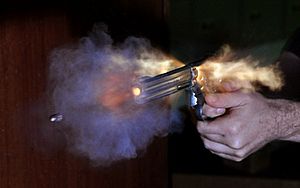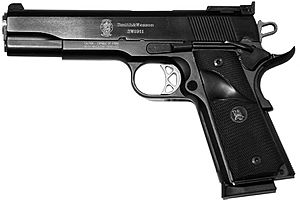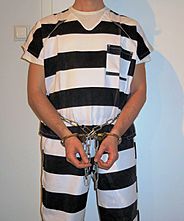- This page was last modified on 17 October 2025, at 10:18. Suggest an edit.
Smith & Wesson facts for kids
 |
|
| Public | |
| Traded as | NASDAQ: SWBI |
| Industry | Manufacturing |
| Founded | 1852 |
| Founders | |
| Headquarters |
,
United States
|
|
Key people
|
|
| Products | Firearms and ammunition |
| Revenue | |
|
Operating income
|
|
| Total assets | |
| Total equity | |
|
Number of employees
|
|
| Footnotes / references Financials as of April 30, 2023[update]. |
|
Smith & Wesson Brands, Inc. (often called S&W) is an American company that makes firearms. Its main office is in Maryville, Tennessee, in the United States.
Smith & Wesson was started by Horace Smith and Daniel B. Wesson in 1856. They named it the "Smith & Wesson Revolver Company." Before this, they had another company, also called "Smith & Wesson Company," which later became "Volcanic Repeating Arms." That first company was sold to Oliver Winchester, who then created the Winchester Repeating Arms Company. Over the years, the modern Smith & Wesson company has been owned by different groups, including Bangor Punta and Tomkins plc. In 2001, Saf-T-Hammer Corporation bought it. From 2016 to 2020, Smith & Wesson was part of American Outdoor Brands Corporation, but then it became its own separate company again in 2020.
History
Early Beginnings: Volcanic Repeating Arms
Horace Smith and Daniel B. Wesson first started a company called Smith & Wesson in Norwich, Connecticut, in 1852. Their goal was to create a new type of gun called the Volcanic rifle. Smith even invented a new cartridge for it, which he patented in 1854.
In 1855, their company was renamed Volcanic Repeating Arms. Soon after, Oliver Winchester bought the company. Horace Smith left, but Daniel Wesson stayed for about eight months. Volcanic Repeating Arms faced financial trouble in 1856. It was later reorganized and eventually became the famous Winchester Repeating Arms Company by 1866.
Forming the Smith & Wesson Revolver Company
Around 1856, a patent for the revolver held by Samuel Colt was about to end. Daniel Wesson started working on a new kind of revolver that used cartridges. He found out that a former employee of Colt's, Rollin White, had a patent for a special "bored-through" cylinder. This cylinder was exactly what Wesson needed for his new invention.
Wesson teamed up with Smith again. They approached White to make a new revolver and cartridge combination. After Wesson left Volcanic Repeating Arms in 1856, he and Smith officially formed the Smith & Wesson Revolver Company. This company is the one that grew into the Smith & Wesson we know today. Instead of making White a partner, Smith & Wesson paid him a small fee for each revolver they made. This deal was very good for Smith & Wesson, but it caused financial problems for White later on.
The 19th Century: Growth and Innovation
Smith & Wesson revolvers became very popular during the American Civil War. Soldiers on both sides often bought these revolvers for self-defense. The demand for the Smith & Wesson Model 1 revolver was so high that the factory couldn't make them fast enough. In 1860, Smith & Wesson moved to a larger facility and started working on better cartridge designs.
Other gun makers tried to copy Smith & Wesson's designs, which led to many lawsuits from Rollin White. Sometimes, the companies that copied the design had to stamp "Manufactured for Smith & Wesson" on their revolvers. White's patent made it hard for other American gun makers to create cartridge revolvers. After the war, the U.S. Government even blamed White for slowing down gun development in America.
When the Civil War ended, the demand for revolvers decreased. Smith & Wesson then focused on making guns for the American frontier. In 1870, they started making larger revolvers that used more powerful cartridges. The U.S. Army chose their new design, called the Smith & Wesson Model 3, as the first cartridge-firing revolver used by the U.S. military.
In 1899, Smith & Wesson introduced one of its most famous revolvers, the .38 Military & Police (also known as the Smith & Wesson Model 10). Over 6 million of these were made, and it became the standard handgun for American police officers for much of the 20th century. An extra 1 million were made for the U.S. Military during World War II.
The 20th Century: New Designs and Challenges
The years after the wars in the 20th century were a time of many new ideas for the company. In 1935, Smith & Wesson released the .357 Registered Magnum. This was the first revolver made for the powerful .357 Magnum cartridge. It was designed to be a stronger handgun for police officers and started the "Magnum Era" of handguns. Later, in 1957, this revolver became known as the Model 27. In 1955, the company created the Smith & Wesson Model 29 for the .44 Magnum. This gun became very famous thanks to the Dirty Harry movies two decades later.
In 1965, the Wesson family sold their part of Smith & Wesson to Bangor Punta, a large American company. Over the next ten years, Smith & Wesson started selling more products for civilians, like holsters. They also offered more equipment for police, such as handcuffs and breathalyzers. By the late 1970s, these changes made Smith & Wesson very successful.
However, Smith & Wesson's market share started to drop in the 1980s. Police departments across the country began to replace their revolvers with European semiautomatic pistols from companies like Glock, Sig Sauer, and Beretta. From 1982 to 1986, the company's profits went down by 41 percent.
In June 1987, a company called Tomkins plc bought Smith & Wesson for $112.5 million. Tomkins updated the factory equipment and added more testing, which greatly improved the quality of the products. But new gun sales in the United States were slow in the 1990s. There were also many lawsuits against Smith & Wesson from cities and states.
The 21st Century: New Ownership and Products
The Clinton Agreement
On March 17, 2000, Smith & Wesson made an agreement with U.S. President Bill Clinton. The company agreed to make changes to how it designed and sold its firearms. In return, the government would give them a "preferred buying program" to help with any money they might lose. The agreement said that all authorized dealers selling Smith & Wesson products had to follow a "code of conduct." This code was meant to stop guns from being sold to people who weren't allowed to have them. Dealers also had to agree not to let children under 18 (without an adult) into gun shops or gun sections of stores.
In response, some gun rights groups, like the National Rifle Association of America (NRA) and the National Shooting Sports Foundation (NSSF), started a campaign against Smith & Wesson. Thousands of stores and many gun buyers stopped buying Smith & Wesson products. The CEO, Ed Schultz, who made the deal, had to leave the company in September of that year. By December 2000, the company's stock price was very low. Smith & Wesson eventually stopped its plans related to the agreement after almost going out of business.
New Owners
On May 11, 2001, Saf-T-Hammer Corporation bought Smith & Wesson Corp. from Tomkins plc for $15 million. This was much less than the $112 million Tomkins had paid. Saf-T-Hammer also took on $30 million in debt, making the total cost $45 million. Saf-T-Hammer made gun locks and other safety products. They bought Smith & Wesson to add their safety products to all Smith & Wesson firearms, as agreed in the 2000 deal.
Bob Scott, the president of Saf-T-Hammer, helped make the deal happen. He had left Smith & Wesson in 1999 because he disagreed with Tomkins' decisions. After the purchase, Scott became the president of Smith & Wesson. He aimed to bring the company back to its strong position in the market. On February 15, 2002, the new company was renamed Smith & Wesson Holding Corporation.
Recent Years
In 2006, Smith & Wesson started focusing its sales efforts on large retail stores. In 2016, Smith & Wesson Holding Corporation changed its name to American Outdoor Brands Corporation.
In 2017, Smith & Wesson's sales dropped significantly. The company had to let go of about a quarter of its manufacturing workers. On August 24, 2020, American Outdoor Brands separated from Smith & Wesson. Smith & Wesson became its own publicly traded company again. As of January 2022, Smith & Wesson had a market value of about $880 million and revenues of over $1 billion.
Products
Cartridges
Smith & Wesson has been involved in developing and using many different types of ammunition cartridges over the years. Here are some of them:
- .22 Short — This cartridge is based on an older design but uses a more powerful powder.
- .32 S&W — Sometimes called .32 S&W Short.
- .32 S&W Long — Also known as .32 Colt New Police.
- .38 S&W — Sometimes called .38 Colt New Police.
- .38-44 S&W — There are two different versions of this. One is for older revolvers, and the other is a stronger version that came before the .357 Magnum.
- .38 S&W Special — Usually just called ".38 Special."
- .357 S&W Magnum — Usually just called ".357 Magnum."
- .40 S&W — Smith & Wesson created this cartridge for the FBI in 1990.
- .41 Remington Magnum — While Remington Arms made the ammunition, Smith & Wesson made the first revolvers for it.
- .44 American
- .44 Russian
- .44 S&W Special
- .44 Remington Magnum
- .45 S&W Schofield
- .460 S&W Magnum
- .500 S&W Magnum — This was designed to be one of the most powerful handguns in the world.
Early Handguns and Revolvers
Smith & Wesson has made revolvers in several standard sizes over the years. These are called frame sizes.
- M refers to the small early Ladysmith frame.
- I refers to the small .32 frame.
- J refers to the small .38 frame.
- K refers to the medium .38 frame.
- L refers to the medium-large .38 and .44 Magnum frame.
- N refers to the largest .44 Magnum type frame.
- In 2003, the even larger X frame was introduced for the .500 S&W Magnum.
Here are some examples of their revolver models:
- Tip-up models
- Smith & Wesson Model 1
- Smith & Wesson Model 1 1/2
- Smith & Wesson Model No. 2 Army
- Top-break models
- S&W .38 Single Action—the first Smith & Wesson revolver made for .38 caliber ammunition.
- Smith & Wesson Model 3—the first to automatically eject spent cartridge cases.
- Smith & Wesson Double Action
- Smith & Wesson Safety Hammerless—also known as the "lemon squeezer."
- I-frame (small) models
- Smith & Wesson Model 30—A small six-shot .32-caliber revolver.
- Smith & Wesson Model 32—"Terrier" A small five-shot revolver for .38 S&W.
- Smith & Wesson Model 34 Kit Gun—A small, 6-shot, .22 Long Rifle revolver. It was made for hunting small animals, target shooting, and pest control. It was designed to be easy to carry in a "kit" for camping or fishing.
- J-frame (small) models
- Smith & Wesson Model 36—known as the "Chiefs Special"; the first J-frame (1950), a 5-shot revolver.
- Smith & Wesson Model 37—known as the "Chiefs Special Airweight."
- Smith & Wesson Model 60—the first regular production all stainless steel revolver (1965).
- Smith & Wesson Model 340PD—the first revolver made of a very light scandium alloy.
- Smith & Wesson Model 617—An 8-shot .22 L.R. revolver with a 3-inch barrel.
- Smith & Wesson Bodyguard—standard and "Airweight" versions.
- Smith & Wesson Centennial—standard and "Airweight" versions.
- K-frame (medium) models
- Smith & Wesson Model 10—.38 Special.
- Smith & Wesson Model 11—.38 S&W.
- Smith & Wesson Model 12—.38 Special. A lighter version of the Model 10.
- Smith & Wesson Model 13—.357 Magnum version of the heavy barrel Model 10.
- Smith & Wesson Model 14—.38 Special.
- Smith & Wesson Model 15—.38 Special.
- Smith & Wesson Model 16—.32 S&W Long Caliber.
- Smith & Wesson Model 17—.22 Caliber.
- Smith & Wesson Model 18—.22 Caliber.
- Smith & Wesson Model 19—.357 Magnum. The first lightweight .357 Magnum.
- Smith & Wesson Model 48—Blued steel .22 Magnum.
- Smith & Wesson Model 53—blued steel .22 Magnum.
- Smith & Wesson Model 64—.38 Special. Stainless steel version of the Model 10.
- Smith & Wesson Model 65—.357 Magnum. Stainless steel version of the Model 13.
- Smith & Wesson Model 66—.357 Magnum. Stainless steel version of the Model 19.
- Smith & Wesson Model 67—.38 Special. Stainless steel version of the Model 15.
- Smith & Wesson Model 68—.38 Special version of the Model 66.
- Smith & Wesson Model 617—.22 Caliber. Stainless steel, 10-shot version of the Model 17.
- L-frame (medium-large) models
- Smith & Wesson Model 386—made of alloy.
- Smith & Wesson Model 586—blued steel.
- Smith & Wesson Model 686—stainless steel.
- Smith & Wesson Model 686+—Same frame as the 686 but holds 7 shots.
- Smith & Wesson Model 619—7-shot .357 Magnum.
- Smith & Wesson Model 620—7-shot .357 Magnum.
- Smith & Wesson Model 646—stainless steel .40 S&W.
- Smith & Wesson Model 69—stainless steel .44 Remington Magnum with 5 shots.
- M-frame (extra small old) models
- Smith & Wesson Ladysmith—Ladysmith in .22 Long.
- N-frame (large) models
- .44 Hand Ejector First Model "New Century"—the first N-frame, introduced in 1908.
- Model 1917—the first revolver made for .45 ACP ammunition.
- Smith & Wesson Model 22—.45 ACP/.45 Auto Rim.
- Smith & Wesson Model 24—The original .44 Special Hand Ejector.
- Smith & Wesson Model 25—similar to the Model 29, but for .45 ACP or .45 Colt.
- Smith & Wesson Model 27—the first .357 Magnum.
- Smith & Wesson Model 28—"Highway Patrolman" .357 Magnum; a simpler, more affordable version of the Model 27.
- Smith & Wesson Model 29—the first .44 Magnum by S&W, made famous by the film Dirty Harry.
- Smith & Wesson Model 57—the first .41 Magnum.
- Smith & Wesson Model 58—.41 Magnum; a basic police duty revolver.
- Smith & Wesson Model 610. A 6-shot revolver for the 10mm Auto cartridge.
- Smith & Wesson Model 625—used by Jerry Miculek to set a world record.
- Smith & Wesson Model 627—8-shot .357 Magnum, stainless steel.
- Smith & Wesson Model 629—6-shot .44 Magnum, stainless steel.
- X-frame models
- Smith & Wesson Model 350 7-shot .350 Legend.
- Smith & Wesson Model 460 5-shot .460 S&W Magnum.
- Smith & Wesson Model 500 5-shot .500 S&W Magnum — designed to be one of the most powerful handguns in the world.
- Z-frame models
- Smith & Wesson Governor
Since Saf-T-Hammer bought the company, most Smith & Wesson revolvers have an internal locking mechanism. This mechanism can be activated with a special key to make the gun unusable.
Semi-automatic Pistols
In 1953, the U.S. Army was looking for a new pistol. Smith & Wesson started working on a design similar to the German Walther P38. The Army later stopped its search, but Smith & Wesson released their pistol to the public as the Model 39.
The Model 39 was known as a "first-generation" pistol. Smith & Wesson kept improving this design, leading to "second-generation" and "third-generation" pistols. First-generation models have 2-digit model numbers, second-generation have 3 digits, and third-generation have 4 digits.
Here are some of their semi-automatic pistol models:
- Smith & Wesson Bodyguard 380
- Smith & Wesson Model 22A
- Smith & Wesson SW22 Victory
- Smith & Wesson Model 39—the first U.S.-designed double-action pistol in 9×19mm.
- Smith & Wesson Model 41
- Smith & Wesson Model 52
- Smith & Wesson Model 59—S&W's first high-capacity double-action pistol in 9 mm.
- Smith & Wesson Model 61—The small 'Escort' pistol, made from 1970 to 1973.
- Smith & Wesson Model 78G
- Smith & Wesson Model 1913 also known as Model 35.
- Smith & Wesson Model 439—an updated Model 39.
- Smith & Wesson Model 459—S&W's entry into the US Army's XM9 program.
- Smith & Wesson Model 469
- Smith & Wesson Model 645—a second-generation large frame semi-auto in .45 ACP.
- Smith and Wesson 539
- Smith & Wesson Model 908
- Smith & Wesson Model 909
- Smith & Wesson Model 910
- Smith & Wesson Model 915
- Smith & Wesson Model 1006—stainless steel 10mm Auto.
- Smith & Wesson Model 1026 with a frame-mounted decocker.
- Smith & Wesson Model 4006
- Smith & Wesson Model 4506—a third-generation large frame semi-auto in .45 ACP.
- Smith & Wesson Model 5906
Sigma Series
In 1994, Smith & Wesson introduced the Sigma series of recoil-operated pistols. These were semi-auto pistols with a locked breech. The first was the Sigma SW40F, followed by the Sigma SW9F 9 mm. Another company, Glock, sued Smith & Wesson for patent infringement. Smith & Wesson paid an amount of money to settle the case so they could keep making Sigma models. The gun's frame is made from polymer, while the slide and barrel are made from stainless steel or carbon steel.
- SW9 in 9×19mm
- SW40 in .40 S&W
- SW357V in .357 SIG
- SW380 in .380 ACP
SW99 Series
S&W made a deal with Walther to produce versions of the P99 pistols. These were called the SW99. They came in different calibers, including 9 mm, .40 S&W, and .45 ACP, and in both full and compact sizes. Walther made the frames, and Smith & Wesson made the slide and barrel.
M&P Series
In 2005, Smith & Wesson launched a new pistol with a polymer frame, designed for police. It was called the M&P (which stands for Military and Police). This name was chosen to remind people of S&W's history of making firearms for law enforcement. The M&P is a completely new design. It looks and feels different from previous models. It also has an improved trigger and a unique way to take it apart.
The M&P is available in 9×19mm, .40 S&W, 5.7x28mm, .22 WMR, and .357 SIG. A .22 LR M&P was also made with Carl Walther in Germany. A .45 ACP model was released in 2007. Smaller, compact versions are also available.
SD VE Series
Smith & Wesson introduced the SD VE series in 2012. This series was an improved version of the earlier Smith & Wesson SD. The SD VE design has a better trigger for self-defense and a comfortable, textured grip. It also has an improved stainless steel barrel and slide. The Smith & Wesson SD VE is available in 9×19mm and .40 S&W calibers.
SW1911 Series
In 2003, Smith & Wesson introduced their own version of the classic M1911 .45 ACP semi-automatic handgun, called the SW1911. This gun keeps the well-known size and feel of the M1911 but adds modern features. These updates include serrations on the front of the slide for easier use, a high "beaver-tail" grip safety, and updated internal safeties to prevent accidental firing if dropped. These changes make the SW1911 a modern version of a classic design.
Rifles and Carbines
During the early years of World War II, Smith & Wesson made some Model 1940 Light Rifles for the British Government, but they did not work out well.
In January 2006, Smith & Wesson started making rifles again with their M&P15 series. These rifles are based on the AR-15 design. They were first shown at the SHOT Show in 2006. The rifles came in two types: the M&P15 and the M&P15T. Both are for the 5.56 NATO cartridge. The T model has folding sights and a rail for accessories. Smith & Wesson now makes the lower part of the rifle themselves, and the barrel comes from Thompson/Center Arms, which is another S&W company.
In May 2008, Smith & Wesson introduced its first AR-style rifle for a different caliber, the M&P15R for the 5.45×39mm cartridge. In 2009, they released the M&P15-22, which uses .22 Long Rifle ammunition.
Smith & Wesson also made a line of bolt-action rifles called the i-Bolt. These rifles had synthetic stocks and were available in different calibers.
Submachine Gun
In 1967, Smith & Wesson made a 9mm submachine gun. They hoped to sell it to the U.S. military and police, like the Israeli Uzi and H.K. MP5. It used the magazine from the Carl Gustaf M/45 submachine gun and had a similar folding stock. The S&W Model 76 submachine gun was made in limited numbers and was mainly used by police.
Shotguns
In 1972, Smith & Wesson bought the rights to a pump-action shotgun design and produced it as the Model 916. These guns had some quality problems. The Model 916 was later replaced by the pump-action Model 3000 and the semi-automatic Model 1000. Both of these were made by Howa Machinery in Japan. However, when Tomkins plc bought the company, Smith & Wesson stopped making shotguns in the mid-1980s to focus on handguns again.
In the 1980s, the company released the Smith & Wesson AS, a shotgun that could fire automatically.
In November 2006, Smith & Wesson announced they would start making shotguns again. They introduced two new lines: the break-open Elite Series and the semi-automatic 1000 Series. Both were made in Turkey. The company also started a special "Heirloom Warranty" program for the Elite Series shotguns. This warranty covered both the original buyer and their chosen heir for life. Both the 1000 Series and Elite Series were stopped around 2010.
In August 2021, S&W announced the first shotgun in its M&P line, the M&P12. This is a bullpup-style pump-action 12-gauge shotgun. It can hold different sizes of shotgun shells.
Other Products
Smith & Wesson also makes restraints like handcuffs, leg irons, and belly chains. They first made handcuffs for the Peerless handcuff company. When Peerless started making their own, Smith & Wesson continued to make similar handcuffs under their own name.
Smith & Wesson sells many other products under its brand name. These include gun accessories, safes, clothing, watches, knives, axes, tools, air guns, and emergency lights.
John Wilson and Roy G. Jinks designed the Smith & Wesson model 6010 Bowie knife in 1971. Blackie Collins designed other knives later. These special knives were made at the factory in Springfield, Massachusetts.
In October 2002, Smith & Wesson announced a deal to make bicycles for law enforcement. These bikes had special features and silent hubs.
Smith & Wesson flashlights are available to the public. They are designed and made by PowerTech, Inc.
Smith & Wesson also has a line of wood pellet grills named after different pistol cartridges.
The company has also partnered with Wellco Enterprises to design and sell tactical footwear for law enforcement.
See also
 In Spanish: Smith & Wesson para niños
In Spanish: Smith & Wesson para niños
- Daniel Leavitt
- Bangor Punta









